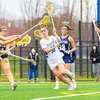 Janet Sung |
Meant to be "user friendly," the recitals will include discussion of the pieces and demonstration of the performance techniques involved. The second recital will take place March 15. Because twentieth-century chamber music reflects a variety of styles, often using fresh compositional techniques, these programs will span "serious" music's trends by presenting works ranging from traditional to highly exploratory.
On Feb. 16, performers will include Shinobu Takagi, Kay Stonefelt, Tiffany Nicely, Matthew Wilson, Mary Marden Cobb, Phyllis East, Janet Sung, Maureen Yuen, David Rose, Natasha Farny, and Mario Falcao.
Featured on the program will be "En blanc et noir," by Claude Debussy, a 1915 work for two pianos. It contains strong classical elements, a programmatic narrative, one movement based on an octatonic scale -- for the average listener an unusual set of pitches – and exemplifies Debussy's highly-sophisticated late writing.
Although not the cornerstone of chamber music literature that it had been during the 19th century, writing for the string quartet was alive and well in the 20th, and Feb. 16's program will showcase one particular work: Stravinsky's "Three Pieces" from 1914. This work combines traditional elements with the new in the work's short condensed writing (in contrast to the late Romantic period’s expansiveness) and use of instruments as guitars.
More radical compositional techniques are used in John Cage's "Amores" for prepared piano and three percussionists. The work dates from 1942 when Cage was deeply influenced by writing for the dance. It is emblematic of the century's increased interest in percussion and percussive sounds, and of using traditional instruments in non-traditional ways. A second, equally innovative Cage work, "The Widow of 18 Springs," is for soprano and piano, also a traditional chamber music grouping approached in a 20th - century style.
Yet another line of musical thought is displayed in selections from Earle Brown's "Folio," written between 1951 and 1953. Here are pieces based in part on new notational methods. These are considered to be "indeterminate," allowing for performance by an unspecified combination of piano and other instruments, all of which will decide much of the musical content at the moment of performance. In effect, these short pieces are a form of improvisation.
Ernst Krenek's harp sonata, written in 1955, was commissioned and is dedicated to the great Spanish harpist Nicanor Zabaleta. While not strictly speaking a chamber work, it is a 20th century example of a classic sonata written in the musical language of free atonalism. Due to its elaborate chromaticism it has a highly challenging pedal technique for the harp.
The next recital, on March 15th, will be equally eclectic, including works by Anton Webern, Lukas Foss, and John Harbison, among others.



